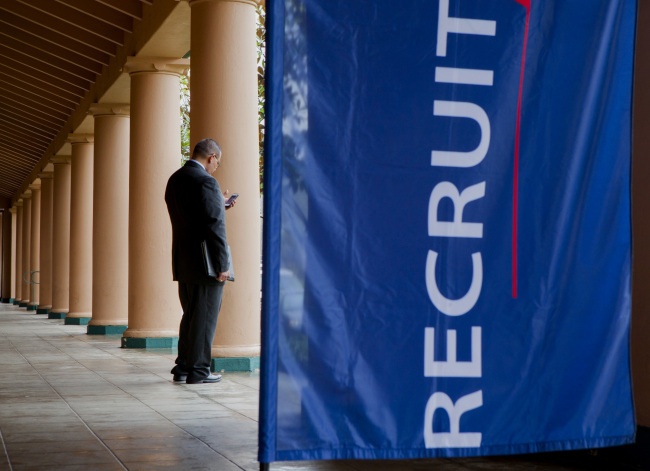 |
A job seeker checks his mobile phone outside of a job fair in San Diego, California, Feb. 27. (Bloomberg) |
WASHINGTON (AP) ― Job growth in the United States has proved surprisingly consistent.
Brutal winter weather snarled traffic, canceled flights and cut power to homes and factories in February. Yet it didn’t faze U.S. employers, who added 175,000 jobs, far more than the two previous months.
Modest but steady hiring has become a hallmark of a nearly 5-year-old economic rebound that remains sluggish yet strikingly resilient. The economy has been slowed by political gridlock, harsh weather and global crises. But those disruptions have not derailed growth.
Though the unemployment rate rose to 6.7 percent from a five-year low of 6.6 percent, it did so for an encouraging reason: More people began seeking work. The unemployment rate ticked up because most did not immediately find jobs.

Friday’s report from the Labor Department suggested that a long-hoped-for acceleration in growth and hiring still has not occurred. But that might not be all bad: Households have pared debt and avoided the excessive spending and borrowing that have undercut explosive economies in the past.
Total U.S. credit card debt is still 14 percent lower than before the Great Recession began in December 2007, according to the Federal Reserve.
And moderate but consistent hiring still means more people have money to spend.
“A modest expansion may very well last longer than one that bursts out with big increases in spending and debt,” said David Berson, an economist at Nationwide Financial.
Some economists also suggested that having endured harsh weather, the economy may be poised to pick up soon.
“If not for poor weather conditions, job growth would have been stronger,” said Michelle Meyer, an economist at Bank of America Merrill Lynch. “This suggests we should see solid gains ... in coming months.”
The figures were a welcome surprise after recent economic data showed that severe weather had closed factories, lowered auto sales and slowed home purchases. Along with a sharp increase in wages last month, the jobs report indicated confidence among some employers that consumer spending will increase in the near future.
The severe winter appeared to have less effect on hiring than most economists had feared. Construction companies, which usually stop work in bad weather, added 15,000 jobs. Manufacturing gained 6,000 for a second straight month. Government added 13,000 jobs, the most in six months.
Daniel Alpert, managing partner at Westwood Capital, noted that roughly two-thirds of the job growth in January and February was in higher-paying industries. That’s a reversal from all of last year, when about two-thirds of job growth was in lower-paying fields.
A category called professional and business services, which includes better-paying jobs such as engineers, accountants and architects, along with some lower-paying jobs such as temporary workers, added 79,000 jobs in February. That was the most in a year.
Retailers, though, lost 4,100 jobs, transportation and warehousing firms 3,600.
Despite February’s solid overall gain, the monthly average of 129,000 jobs that employers have added from December through February marks the weakest three-month stretch since mid-2012. It’s down from a 225,000 average for the previous three months.
The government revised up its estimate of job gains for December and January by a combined 25,000.
Friday’s report makes it likely that the Federal Reserve will continue reducing its monthly bond purchases at its next meeting March 18-19. The Fed is buying Treasury and mortgage bonds to try to keep long-term loan rates low to spur growth. Fed policymakers have reduced their monthly bond purchases by $10 billion at each of their past two meetings to $65 billion.
On Monday, Karen Wilson will start her first full-time job with benefits in nearly eight years. As a data-entry clerk for Peoria County, Ill., she will process traffic tickets, drunk-driving violations and other citations.
After a layoff in 2006, the 42-year-old worked several part-time jobs and got financial aid to return to school. Her car broke down last Thanksgiving night after accumulating 153,000 miles. She’s had to wait for a bus in freezing temperatures.
Still, things are looking up. Though her new job pays just $12 an hour, “it’s a foot in the door, and it can lead to so many other things,” Wilson said. “I will actually get a lunch hour.”









